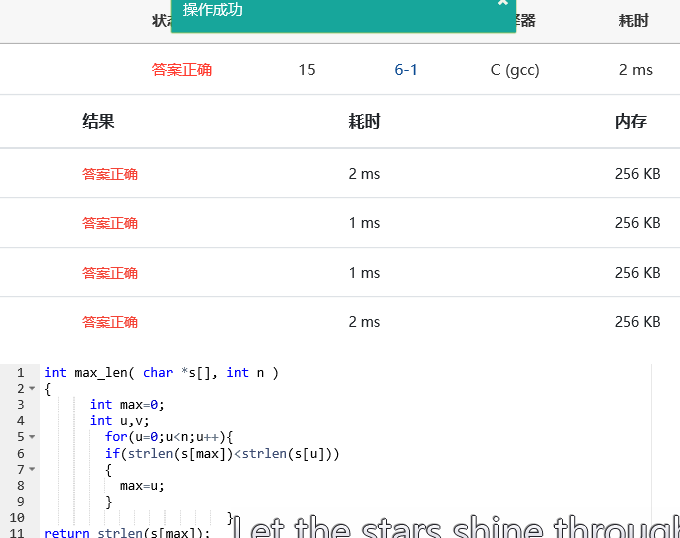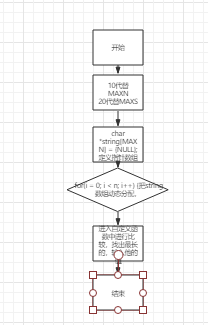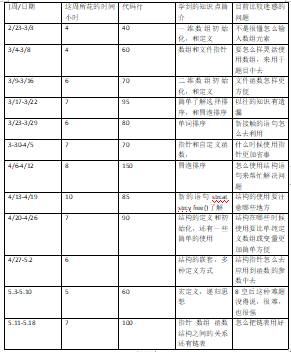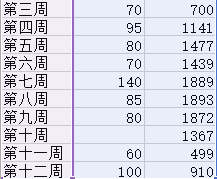12周作业
| 这个作业属于哪个课程 | C语言程序设计Ⅱ |
|---|---|
| 这个作业要求在哪里 | https://edu.cnblogs.com/campus/zswxy/software-engineering-class2-2018/homework/3234 |
| 我在这个课程的目标是 | 理解指针数组,二级指针,函数指针 |
| 这个作业在哪个具体方面帮助我实现目标 | 指针与数组,函数,结构的联系 |
| 参考文献 | C语言程序设计第11章 |
6-1 计算最长的字符串长度 (15 分)
本题要求实现一个函数,用于计算有n个元素的指针数组s中最长的字符串的长度。
函数接口定义:
int max_len( char *s[], int n );
其中n个字符串存储在s[]中,函数max_len应返回其中最长字符串的长度。
裁判测试程序样例:
#include <stdio.h>
#include <string.h>
#include <stdlib.h>
#define MAXN 10
#define MAXS 20
int max_len( char *s[], int n );
int main()
{
int i, n;
char *string[MAXN] = {NULL};
scanf("%d", &n);
for(i = 0; i < n; i++) {
string[i] = (char *)malloc(sizeof(char)*MAXS);
scanf("%s", string[i]);
}
printf("%d\n", max_len(string, n));
return 0;
}
实验代码
int max_len( char *s[], int n )
{
int max=0;
int u;
for(u=0;u<n;u++){
if(strlen(s[max])<strlen(s[u]))
{
max=u;
}
}
return strlen(s[max]);
}
实验思路: 定义一个变量给初始值为0;在strlen函数中看是否(s[max])<strlen(s[u]),是就把u赋值max,否则u加1,再次比较,直到u大于等于n或满足(s[max])<strlen(s[u]))结束循环,输出strlen(s[max])
正确截图:
流程图:
6-2 统计专业人数 (15 分)
本题要求实现一个函数,统计学生学号链表中专业为计算机的学生人数。链表结点定义如下:
struct ListNode {
char code[8];
struct ListNode *next;
};
这里学生的学号共7位数字,其中第2、3位是专业编号。计算机专业的编号为02。
函数接口定义:
int countcs( struct ListNode *head );
其中head是用户传入的学生学号链表的头指针;函数countcs统计并返回head链表中专业为计算机的学生人数。
裁判测试程序样例:
#include <stdio.h>
#include <stdlib.h>
#include <string.h>
struct ListNode {
char code[8];
struct ListNode *next;
};
struct ListNode *createlist(); /*裁判实现,细节不表 例:*struct node* createlist()这是一个函数,返回类型是struct node*/
int countcs( struct ListNode *head );
int main()
{
struct ListNode *head;
head = createlist();
printf("%d\n", countcs(head));
return 0;
}
/* 你的代码将被嵌在这里 */
int countcs( struct ListNode *head )
{
int i = 0;
while(head)
{
if(head->code[1] == '0' && head->code[2] == '2')
i++;
head = head->next;
}
return i;
}
输入样例:
1021202
2022310
8102134
1030912
3110203
4021205
#
输出样例:
3
实验思路: 自定义函数在指针函数中找出第二位和第三位为02的编号,满足条件加1。返回他的值,输出.
正确截图:
流程图:
6-3 删除单链表偶数节点 (20 分)
本题要求实现两个函数,分别将读入的数据存储为单链表、将链表中偶数值的结点删除。链表结点定义如下:
struct ListNode {
int data;
struct ListNode *next;
};
函数接口定义:
struct ListNode *createlist();
struct ListNode *deleteeven( struct ListNode *head );
函数createlist从标准输入读入一系列正整数,按照读入顺序建立单链表。当读到−1时表示输入结束,函数应返回指向单链表头结点的指针。
函数deleteeven将单链表head中偶数值的结点删除,返回结果链表的头指针。
裁判测试程序样例:
#include <stdio.h>
#include <stdlib.h>
struct ListNode {
int data;
struct ListNode *next;
};
struct ListNode *createlist();
struct ListNode *deleteeven( struct ListNode *head );
void printlist( struct ListNode *head )
{
struct ListNode *p = head;
while (p) {
printf("%d ", p->data);
p = p->next;
}
printf("\n");
}
int main()
{
struct ListNode *head;
head = createlist();
head = deleteeven(head);
printlist(head);
return 0;
}
/* 你的代码将被嵌在这里 */
struct ListNode *createlist(){
int x;
struct ListNode *head,*tail,*p;
head=(struct ListNode*)malloc(sizeof(struct ListNode));
head->next=NULL;
tail=head;
while(1) {
p=(struct ListNode*)malloc(sizeof(struct ListNode));
p->next=NULL;
scanf("%d",&x);
if(x==-1)
break;
p->data=x;
p->next=NULL;
tail->next=p;
tail=p;
}
return head;
}
struct ListNode *deleteeven( struct ListNode *head ){
struct ListNode *p1,*p2;
int flag;
p1=head;
p2=p1->next;
while(p1->next) {
flag=0;
if(p2->data%2==0)
{
p1->next=p2->next;
p2=p2->next;
flag=1;
}
if(flag==0)
{
p1=p1->next;
p2=p1->next;
}
}
return head->next;
}
实验思路: 和书上例题稍微类似,他这里是俩个函数一个函数createlist从标准输入读入一系列正整数,按照读入顺序建立单链表。当读到−1时表示输入结束,函数应返回指向单链表头结点的指针。一个函数deleteeven将单链表head中偶数值的结点删除,返回结果链表的头指针。
正确截图:
流程图:
结对感想;有些东西就是得自己去找答案,然后去从别人那里去学习,书上的东西也不是每个地方都懂.
函数名带括号带指针的就是函数指针,否则就是指针函数
p=(int)malloc(sizeof(int)(n+1))是sizeof(int)(n+1) 是求一个字节数的过程
sizeof(int)就是int类型的字节数,再(n+1),其实就是连续的n+1个int型数的空间所含的字节数
前面二者合起来就是分配了大小为n+1个int型的空间所含的字节数





